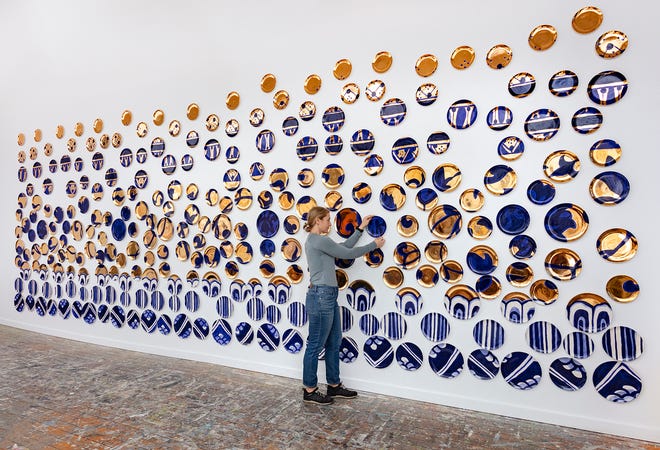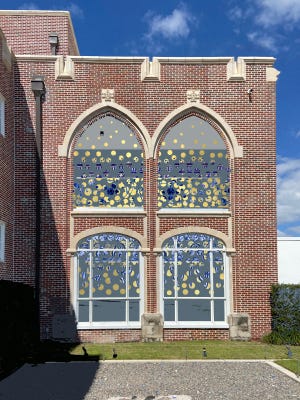The word “amalgam” arose in the no-man’s land between metallurgy and alchemy. Mixing mercury with base metals was the meaning. Creating gold was often the goal. Molly Hatch’s “Amalgam” (2024) creates a golden alchemy of its own at Sarasota Art Museum.
Hatch’s site-specific installation features 470 ceramic plates spanning two floors of the museum. Her original, hand-painted earthenware plates come in colors – white, cobalt blue, and 22-karat gold luster. Each plate is beautiful; each is part of a whole. “Amalgam” is a unified creation – a single work of art. It’s also art about art.
“Amalgam” references the complicated global history of ceramics – a tangled tale of art, trade and cross-cultural influence. China was the birthplace of this art form. (It’s why we call it “China,” after all.) Hatch honors that origin – and skillfully blends, deconstructs, and reinterprets traditional motifs in her own pieces. Each plate is an extreme close-up of one such beautiful pattern. Seen from a distance, the installation’s multitudinal references melt into one abstraction. Seen in context, it’s a meditation on connections forged across culture and time. Hatch reflects on those connections in the following conversation.
What’s the genesis of this installation?
It began with a commission. When Virginia Shearer, the museum director, first contacted me, I immediately accepted. It was a great opportunity for me. I typically work with specific collections that acquire my work …
Need a break? Play the USA TODAY Daily Crossword Puzzle.
Ah. You mean existing pieces. They’re selecting work you’ve already done.
Exactly. Working on commission with a non-collecting museum gave me carte blanche to create new work and reference broader historical concepts. I could explore a vast range of ceramic history, culturally and geographically. I decided to focus on the history of blue-and-white ceramics and their significance and appropriation over time. It’s a great lens for global trade and cross-cultural influences.

Did you already know that history?
Some of it. But to create this installation, I researched various sources of ceramic development in Africa, Asia, Europe, America, and South America. I ultimately incorporated patterns and motifs from these different sources in my pieces. But I’m referencing the actual history, not reimagining it from scratch.
So “Amalgam” has an embedded art history lesson.
Absolutely. We live in a time when it’s crucial to remember our global cultural unity. I wanted to reflect on something historically unifying like blue-and white ceramics. There are several shared motifs flowing through many ceramic traditions around the world. These patterns and colors originated in different, specific cultures, but they became a universal language

Is your installation a single work of art? Or an amalgam of 470 different artworks?
Excellent question! I’d say it’s one piece experienced on multiple levels. As you navigate the museum, you see the installation unifying two floor levels, creating the optical illusion of one consistent wall. Up close, you experience the individual aspects of the art walk and loggia. While there’s a large, overarching image, the abstraction and detailed patterns become clearer as you approach. The experience keeps changing, and you’re rewarded for closer inspection.
Your installation is spatially static, but fluid in time. The viewer’s perception changes as they move through it. It’s not a passive experience.
No, it isn’t. My piece asks the viewer to see patterns and put them back together, both visually and metaphorically. By deconstructing and reconstructing these patterns, you can take a fresh look at familiar motifs, and create a deeper relationship with them.
Where’d these patterns originate?
The motifs began as Chinese patterns designed for export, primarily to the West. Historically, the West’s interest in blue-and-white ceramics came from the East. The purest cobalt is Persian, prized by the Chinese for their porcelains, which were then exported to Europe in the 17th century. Europeans coveted these porcelains, and that led to Western interpretations of Eastern motifs, and the development of similar wares in places like Holland.
Were China’s porcelain exports the same as the pieces you’d find in China?
No. These porcelains were specifically made for European consumption. They reflected Chinese notions of European tastes, not their own tastes.
Supply and demand, in other words. The Chinese were giving European customers what they wanted. Or thought they wanted.
Yes. Porcelain trade created layers of cultural interpretation and re-interpretation, making these patterns a global heritage, not the possession of any single culture. This interconnectedness is central to the work.
And how does your installation reflect that heritage?
My plates were cast in China, and some tiles were handmade in my studio. I hand-painted the plates’ surfaces with cobalt-rich glazes – which is similar to historical techniques. I finished the pieces using a low-fire enamel process with 24-karat gold luster.
That sounds pretty grueling.
It’s an intensive process, absolutely. I worked with two assistants on this project. We went through so many, many firings – and over 1,200 hours of hand-painting and luster work. It took us over nine months to paint it all. My work on this installation honors the labor-intensive nature of the original porcelains. It’s my homage to the original ceramic artists.
Arts Newsletter:Sign up to receive the latest news on the Sarasota area arts scene every Monday
Architect Victor Lundy:Sarasota Art Museum exhibit rediscovers a masterpiece of architecture
You’re creating personal connections across time.
Yes, and those connections are essential to my installation. The beauty of these ceramics isn’t just aesthetic. There’s equal beauty in their deep historical and cultural significance. So, many of my pieces are laden with gold. Gold is beautiful. But gold also reflects the viewer back into the work. Viewers can literally see themselves in my art.
Your art’s a mirror image of the viewer, and vice versa. The two become one.
You could say that. The reflective gold surfaces honor the history of porcelain. By pulling the viewer into the work, my plates emphasize our shared cultural connections, and the legacy passed down by the artists of the past. Historically, culturally and artistically, it all comes full circle.
‘Molly Hatch: Amalgam’
Runs through April 26, 2026, at Sarasota Art Museum, 1001 South Tamiami Trail, Sarasota; (941) 309-4300; sarasotaartmuseum.org